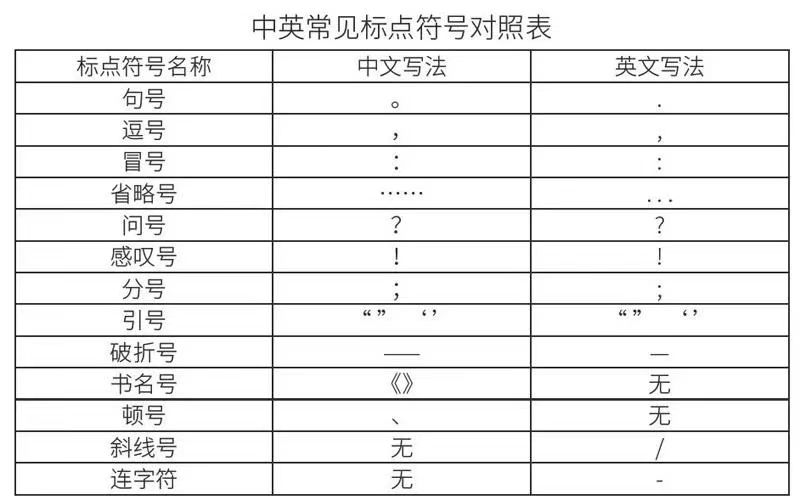常用的英语标点符号有十二种,它们是:
01.Apostrophe 省字符(')
02.Comma 逗号(,)
03.Colon 冒号(:)
04.Dash 破折号(--)
05.Exclamation Mark 惊叹号(!)
06.Hyphen 连字符(-)
07.Parentheses 括号 ( )
08. Period 句号(.)
09. Question Mark 问号(?)
10.Quotation Marks 引号(" "或' ')
11.Semicolon 分号(;)
12.Triple Dots(Ellipsis) 删节号(省略号)(...)
现将各种标点符号的用法分别说明如下:
1. 省字符(')
(1)表示字母的省略。Can't you read those road signs?
(2)表示数字的省略。Today is Thursday, June 1, '89.
(3)表示字母的复数。There are five s's in "sleeplessness."
(4)表示单词的复数。Our teacher told us not to use so many so's.
(5)表示数字的复数。Her 7's and 9's look alike.
(6)表示所有格。It's Tom Bovey's umbrella.
2. 逗号(,)
(1) 用在以and ,but ,for, nor ,or ,so ,yet等连词连接的两个主要子句之间。
My father is fond of fishing, but my mother prefers hiking.
(2) 在复合句中,如果附属从句在前,主句在后,用在附属从句之后。
While I was making a telephone call, someone knocked at my door.
注意:如果主句在前,则不用逗号。
(3) 用以分开非限制性形容词从句与主句。
Her father, who is a famous scholar, teaches English.
(4) 用以分开非限制性同位语。
Tom Bovey, my English teacher, is from America.
(5) 用在yes, no ,well等词之后。
(a) Yes, he is a hard-working student.
(b) No, it is impossible.
(c) Well, you may go if you insist.
(6) 向人说话时,用在对方名字或称谓之后,之前或前后。
(a) Tom, come here.
(b) Open the door, John.
(c) It is, Sir, not my fault.
(7) 用以分开引用句
(a) "You are beautiful," he said.
(b) Our teacher said, "Freedom is not license."
(c) "No," she said, "I was just testing your patience."
(8) 用以分开星期,月日,年份。
On Sunday, May 28, 1989, her first child was born.
(9) 用以分开地名、省名、国名、街道名、巷弄名等。
Tom lives at 4 Alley 10, Lane 76, Korean Street, Section 5, Fushun, China.
(10)用以分开一系列的单词,词组或从句。
(a) Her mother sells tomatoes, potatoes, and peaches.
(b) She ran up the stairs, across the porch, and into the house.
(c) We all agreed that she was beautiful, that she was intelligent, and that she was ambitious.
(11)用以表示单词的省略。
The lion is the symbol of courage; the lamb, of meekness. (the lamb is the symbol of meekness).
(12)用在such as及especially的前面。
(a) They enjoy outdoor sports, such as hiking and riding.
(b)He likes all extracurricular activities, especially basketball playing.
(13)用以分开「乃此非彼」的结构。
He wanted to see Cliff, not Steve.
(14)用在追问句之前。
It is warm today, isn't it?
3. 冒号(:)
(1) 用在解释或逐项列举之前(在as follows, the following as these或given
below之后)。
(a) I bought the following articles: sheets, towels, and blankets.
(b) The table lamp consists of three parts: a stand, a bulb, and a shade.
(2) 用在正式或事务信函中称谓之后。
Dear Sir: Dear Mr. Bovey: Gentlemen:
注意:在非正式或交际信函中称谓之后用逗号。
Dear Mary, Dear John,
(3) 用在数字之后,表示时间。
Our class starts at 8:10 a.m. and ends at 12:00 noon.
(4) 用在较长的引用句或正式问句之前。
(a) This is my favorite quotation: "It is difficult to say what is impossible, for the dream of yesterday is the hope of today and reality of tomorrow."
(b) The question is: What can we do for our country?
(5) 用在解释第一个主要从句的第二个主句之前。
Her intention is obvious: she wants to marry him.
4. 破折号(--)
(1) 表示犹豫,句意的暂时中断, 或思想的突然中断。
(a) I--I don't know. You'd better ask her.
(b) The entire teaching facilities--console, tapes, earphones, and tape recorders--were stolen last night.
(c) I'll give--let's see, what can I give?
(2) 用以强调同位语。
She has only one interest--food.
(3) 用在结语之前。
Professor Bovey collects postage stamps, coins, sea shells, matchboxes--in short,
anything that interests him.
(4) 用在未完成句子之后。
She said, "He was everything to me, but--"
5. 惊叹号(!)
(1) 用在以强烈情感说出的字句之后。
(a) What a surprise!
(b) How beautiful a girl she is!
(c) What a beautiful girl she is!
(2) 用在祈使句之后。
(a) Help! My house is on fire!
(b) Be quiet!
6. 连字符(-)
(1) 用以表示分数或连接由21至99中的十位数及个位数。
(a) Three-fourths of the freshman students are girls.
(b) There are twenty-two boy students and ninety-eight girl students in the Department of English.
(2) 用在行末连接分写的单词。
He is a graduate student of National English Uni-
versity.
(3) 用以连接复合词中的各词。
We had a heart-to-heart talk last night.
7. 括号( )
用来在句中附加评论或解释。
I saw the two students (they are lovers) kissing each other.
8. 句号( . )
(1) 用在叙述句,祈使句及礼貌问句之后。
(a) I wish to enter an ideal university.
(b) Turn in your papers, please.
(c) Will you please send me a dictionary.
(2) 用在间接问句之后。
She asked if you would come to her birthday party.
(3) 用在缩写名字和其他词的第一个字母之后,或缩写字之后。
(a) Prof. Z. G. Wang has returned to Fushun.
(b) Dr. Bovey earned his Ph. D. degree from Georgetown University in Washington, D. C. (District of Columbia).
9. 问号(?)
(1) 用在直接问句之后。
Do you find English writing difficult?
(2) 用在括号中表示存在疑惑。
Chaucer was born in 1340(?) and died in 1400.
10. 引号(" "或' ')
(1) 用在引用句的前后。
(a) Our teacher said, "All work and no play makes Jack a dull boy."
(b) "I don't like her, " she explained, "because she is far too proud."
(2) 如果引用句本身是叙述句而且位于一个问句之后,必须先用引号,再用问号。
Did he say, "I am going to college next year"?
如果引用句本身是问句,则必须先用问号,再用引号。
Did he say, "Are you going to college next year?"
(3) 引用文句有两段或两段以上时,只在每一段开始时和最后一段结束时用引号。
"Mom and Dad did not come home with them because Sunday was parents' day off; the boys did the housework and cooked the meal of the week, while Father and Mother stayed on for church service.
"But by the time diner was ready the boy had climbed into bed. The shoe had to be cut off his swollen and discolored leg. Why on earth hadn't he told somebody? Go quickly and fetch the doctor!"
(4) 引用句中另有引用句时, 用单引号表示
She said, " I quite agree to the saying 'To love and to be loved is the greatest happiness on earth'."
注意:美式英文中,双引号在外,单引号在内,英式英文中恰好相反。
11. 分号 (;)
(1) 用以连接两个或两个以上的主要分句。
(a) The singular form is mouse; the plural form is mice.
(b) she made up her mind; she laid her plans; she began her trip.
(2) 用在连接两个主要从句的连接副词 (consequently, however, moreover, nevertheless, so, still, then, therefore, thus, etc.)之前。
He did not pass the examination; therefore, he was unhappy.
(3) 用在连接两个主要从句的连接词 (and, but, or, nor, for)之前,当主要从句本身有逗号时。
Henry, a freshman, lives at home; but Karl, his brother, does not.
12. 删节号(省略号)(...)
用以表示引用句中省略的文字。如删节号用在句尾,另加原句句尾的标点符号。
In his essay LUCK Winston Churchill wrote: "The longer one lives, the more one realizes that everything depends upon chance... a man's own contribution to his life story is continually by an external superior power."
注意:英文中表示「等等」用etc.而不是用删节号(...)。
另外,需要注意以下情况:
1、没有标点符号难以理解的例句
(a) After eating the child left the table 乍看起来,好像是:「吃完那小孩以后...」。有了标点符号之后的句子是:After eating, the child left the table. 「吃完之后,那小孩离开了餐桌」。
(b)Inside the dog was growling乍看起来,好像是:「那只狗的肚子里在咆哮」。有了标点符号之后的句子是:Inside, the dog was growling. 「门里面,那只狗在咆哮」。
(c)What do you think I mend for nothing and give you two dollars乍看起来,好像是:「我免费给你补(鞋)之外,还要送你两块钱,你以为如何?」。有了标点符号之后的句子是:
What! do you think I mend for nothing and give you two dollars?
「什么?!你以为我免费给你补(鞋)之外,还给你两块钱吗?」
2、增减标点符号的例句
(a)Happily he died.
他含笑而终。本句中happily修饰died.
Happily, he died.
真高兴,他死了。本句中happily修饰 he died.
(b) No tax will be imposed on foreign fruit trees.
外国进口之果树将不征税。
No tax will be imposed on foreign fruit, trees.
外国进口之水果,树将不征税。
(c) Dr. Johnson, our family doctor cannot come today.
詹生医师,我们的家庭医师今天不能来。
本句是向詹生医师传达一项讯息。
(d)Dr. Johnson, our family doctor, cannot come today.
我们的家庭医师詹生今天不能来。
本句中our family doctor 是Dr. Johnson 的同位语。

